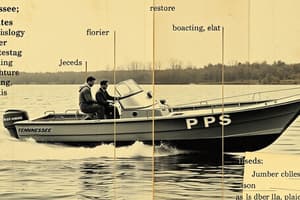Podcast
Questions and Answers
What is the front of a boat called?
What is the front of a boat called?
- Stern
- Starboard
- Port
- Bow (correct)
What is the rear of a vessel called?
What is the rear of a vessel called?
stern
What is the right side of a vessel called?
What is the right side of a vessel called?
starboard
What is the left side of a vessel called?
What is the left side of a vessel called?
What does the hull of a ship refer to?
What does the hull of a ship refer to?
What is the gunwale on a boat?
What is the gunwale on a boat?
What does a propeller do?
What does a propeller do?
What is the maximum width of a vessel called?
What is the maximum width of a vessel called?
What is freeboard in relation to a boat?
What is freeboard in relation to a boat?
What does draft refer to in boating?
What does draft refer to in boating?
What is the keel of a vessel?
What is the keel of a vessel?
What is true about displacement hulls?
What is true about displacement hulls?
What characterizes planing hulls?
What characterizes planing hulls?
What is a personal watercraft?
What is a personal watercraft?
What happens to a planing hull at higher speeds?
What happens to a planing hull at higher speeds?
What are the advantages of a flat bottom hull?
What are the advantages of a flat bottom hull?
What is one advantage of a deep vee hull?
What is one advantage of a deep vee hull?
What is the main advantage of a round bottom hull?
What is the main advantage of a round bottom hull?
What does vessel length dictate?
What does vessel length dictate?
What is the classification for a vessel less than 16 feet?
What is the classification for a vessel less than 16 feet?
What is an outboard engine?
What is an outboard engine?
Flashcards are hidden until you start studying
Study Notes
Boat Parts and Terminology
- The bow is the front of a boat.
- The stern is the rear of a vessel.
- The starboard is the right side of a vessel.
- The port is the left side of a vessel.
- The hull is the frame or body of a ship.
- The gunwale is the upper edge of the side of a boat or ship.
- A cleat is a metal fitting on which a rope can be fastened.
- A propeller rotates and powers a boat forward or backward.
- The beam is the maximum width of a vessel.
- The freeboard is the distance from the water to the lowest point of the boat where water could come on board.
- The draft is the depth of water needed to float a vessel.
- The keel is the main centerline (backbone) of a vessel or the extension of the hull that increases stability in the water.
Hull Types
- A displacement hull moves through the water by pushing the water aside and is designed to cut through the water with very little propulsion.
- Displacement hulls are limited to slower speeds and are typically found in large cruisers and sailboats.
- A planing hull is designed to rise up and glide on top of the water when enough power is supplied.
- Planing hulls may operate like displacement hulls at slow speeds but climb toward the surface of the water as they move faster.
- Planing hulls are typically found in small power-driven vessels, including personal watercraft (PWC), and some small sailboats.
Planing Hull Speeds
- Displacement mode: a planing hull cuts through the water like a displacement hull at very slow speeds.
- Plowing mode: a planing hull has a raised bow, reducing the operator's vision and throwing a large wake, at increased speeds.
- Planing mode: a planing hull glides on top of the water when enough power is applied.
Hull Shapes
- Flat bottom hull: has a shallow draft, but rides roughly in choppy waters.
- Deep Vee hull: gives a smoother ride than a flat bottom hull in rough water, but takes more power to move at the same speed.
- Round bottom hull: moves easily through the water even at slow speeds, but has a tendency to roll unless it has a deep keel or stabilizers.
- Multi hull: has greater stability due to its wide beam, but needs a large area when turning.
Vessel Length and Equipment
- Vessel length dictates the equipment the vessel must have to comply with federal and state laws.
- Length overall is measured from the tip of the bow in a straight line to the stern of the vessel.
- Bowsprits, rudders, outboard motors, and other fittings are not included in the measurement.
Length Classes
- Class A: less than 16 feet
- Class 1: 16 feet to less than 26 feet
- Class 2: 26 feet to less than 40 feet
- Class 3: 40 feet to less than 65 feet
Outboard Engines
- Have more power per pound of weight than inboard engines.
- Are a portable, self-contained package of an engine, gear case, and propeller that is attached to the transom of a boat.
- Many are of four-stroke design.
Studying That Suits You
Use AI to generate personalized quizzes and flashcards to suit your learning preferences.




